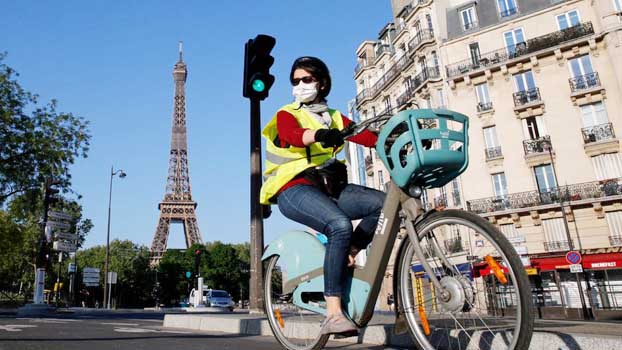Let’s not sleepwalk into new European lockdowns
Spain, France and the UK have a shot at turning things around provided Covid-19 fatigue doesn’t take hold

If the number of lily pads on a pond doubles every day, and it takes 29 days for them to cover the entire pond, on what day is the pond half-covered?
This brainteaser is how Martin Hirsch, head of the Paris region’s hospital network, describes the brutal first wave of Covid-19 that triggered lockdowns across Europe in March and April. The answer is 28, because once the pond is half-covered it only takes one extra day for the lily pads’ spread to double in size. “One day’s delay means double the cases, double the seriously ill, and double the deaths,” he writes in a new book about hospitals battling the virus. “Every day counts.”
Hirsch’s metaphor has relevance for the new surge in Covid-19 cases currently hitting Spain, France and the UK The pick-up certainly looks like a lily pad in full flow.
Deaths are rising at a slower rate, yet they’re also clearly on the rise. The comfort here is they’re averaging at 100 or below per week in those same countries — while tragic, that’s a far cry from peak levels of 1,000 seen during the lockdowns last spring. Mass test-and-trace programs rolled out in the summer have caught asymptomatic and mild cases earlier, while the seriously ill are better treated and less likely to die, doctors say. But the fear is that by the time death rates spike noticeably, it will be too late to do anything about it.
It’s clear that several big European countries have been behind the
curve on Covid-19. They lack the pandemic muscle memory of Asia,
and the natural defenses of low population density. But that doesn’t
mean they’re fated to lock down again. Sometimes lily pads can be
contained without draining the pond.
That’s why epidemiologists and stock market investors see national lockdowns as a rising risk, even as leaders from France’s Emmanuel Macron to Britain’s Boris Johnson have said they’d rather learn to live with the coronavirus than impose another set of draconian restrictions on people’s movement.
Government scientists predict the UK could be reporting 50,000 daily cases by mid-October, up from the current rate of almost 4,000; France and Spain are already averaging about 10,000. The temptation to shutter stores, businesses and schools for a short period, however painful, might be impossible for governments to ignore if this gets worse. Rather than assume the lily pad will spread unchecked as before, though, there are a few reassuring factors to keep in mind.
Unlike in the first wave, when lockdowns seemed the only way to buy time to relieve overwhelmed hospitals and save lives, we know a lot more about SARS-Cov-2. Governments have improved surveillance from the top via testing, tracing and isolation of positive cases to identify and break the chain of transmission. Individuals have stepped up prevention — mask wearing, hand washing and social distancing — to hinder the virus’s ability to spread. On the curative front, as we wait for game-changer vaccines and therapies, steroids and blood-thinners have improved patient recovery in the hospital. The equipment shortages that cruelly exposed frontline workers, from supermarket cashiers to medical staff, are nowhere near as bad as they were in April.
There’s still room to put renewed focus on all of these interlocking measures and tougher local strictures that have been used in cities and regions when cases jump, without putting entire countries in a bell jar. This isn’t just about economic self-interest. The high price of blanket curbs included rising inequality, as school closures hurt children’s education for little epidemiological gain, and delays in potentially life-saving cancer screening.
The challenge is time and public trust. Targeted measures have been slow in coming, and hospitals are starting to fill up again. Covid-19 patients now account for 20%-30% of ICU beds in the Paris and Madrid regions. Testing systems are being stretched to the limit, in some places to the point of collapse. It’s easy to see how confidence in the authorities could evaporate. People might simply take matters into their own hands, veering between fear (self-imposed restrictions on movement) and fatigue (giving up on social distancing). The result would be sleepwalking into lockdown.
This is where transparency and trust come into play. Governments should be clear about their strategy, which sometimes seems to veer between letting the virus circulate (such as restoring nightlife and tourism too hastily) and suppressing it outright. They should avoid flip-flopping on public-health messages, taking a page out of Sweden’s book, which has kept its rules broadly stable since the beginning of the pandemic. And they should take comfort from Italy’s current success in keeping the virus in check, as well as the effectiveness of local lockdowns seen in several countries. Second waves can still be stopped, or at least slowed down.
It’s clear that several big European countries have been behind the curve on Covid-19. They lack the pandemic muscle memory of Asia, and the natural defenses of low population density. But that doesn’t mean they’re fated to lock down again. Sometimes lily pads can be contained without draining the pond.
Lionel Laurent is a Bloomberg Opinion columnist covering the European Union and France. He worked previously at Reuters and Forbes.
Source: Bloomberg



